ANNEALING UNDER THE MICROSCOPE
Part 3
Alex Findlay - 16/07/2018
·
The effect of case weight variations on
annealing is more significant in some brands than others. If weight variations
are only
located in the case heads, then annealing is unaffected. If a portion of the
variation is in the neck and shoulder, then annealing results will vary. Premium
brands such as Lapua, Peterson and Norma tend to have small spreads of weight across
any given lot. What weight variations do exist tend to be located in the
case head, where it doesn’t affect annealing. In other brands tested in this
study there is a direct correlation between case weight and annealing results,
indicating that at least part of the weight variation in those brands is in the
neck
and shoulder region.
·
If weight
variation is present in the neck and shoulder, then AZTEC will tend to
generate a wider spread of annealing codes if multiple cases are sacrificed.
Likewise, annealing those cases will result in a wider spread of neck/shoulder
hardness than the premium brands.
………………………………………………………………..
Introduction:
Many reloaders choose to batch their cases by weight, while
others do not believe it is necessary. We cannot comment on downrange accuracy
results, but we have studied the effects of variable case weight on annealing
quite comprehensively. From analysing thousands of samples, we know that
variable case weight can be a factor, but not always. Why
would that be so?
The following paper sets out to answer the following
questions:
1.
Does variable case weight result in variable
annealing hardness?
2.
If so, what is an acceptable tolerance?
3.
Are some brands better than others?
4.
Where in the case does the weight variation
occur? The head, the neck and shoulder, or all over?
5.
What is responsible for AZTEC analysis
generating different annealing codes for the same brass?
Note: In previous studies we have confirmed that case trim
length is not a significant factor in either AZTEC generated codes or finished
annealing hardness. We have also established long ago that consistent average
neck wall thickness is critical.
How AZTEC case
analysis works:
The first part of
the AZTEC Analysis process is to insert the correct pilot and enter the correct
AZTEC pilot code into the annealer. The pilot
code instructs AZTEC as to what type of cartridge it is analysing i.e. 223
Rem., 308 Win. etc. Some pilots accommodate multiple different cartridges. The
pilot code suffix (A, B, C etc.) is what distinguishes them for AZTEC.
Once a sacrificial case is inserted and
"Start” is pressed, AZTEC "Analyse” mode applies a continuous and precise
amount of power to the targeted zone of the case until the exact instant that a
datum point is reached. In general terms, the longer it takes to reach the
datum, the greater the mass of brass in the targeted zone. The capture is
extremely accurate and reliable. A patent is pending. By referencing the datum
point, AZTEC calculates the correct annealing setting. The calculation, or
algorithm, varies from cartridge to cartridge. Extensive laboratory
micro-Vickers hardness testing has determined these algorithms.
When AZTEC was first released, the annealing codes were not
sequential, making them confusing for some users. The AZTEC annealing codes are
now linear,
meaning that each ascending number delivers incrementally more energy to the
case neck and shoulder i.e. 0128 is a fraction more power than 0127. The
increments are very fine. These linear codes are what makes the following study
possible.
Methodology.
We started with virgin brass from six different
manufacturers. We weight sorted each pack from lightest to heaviest as shown
here:
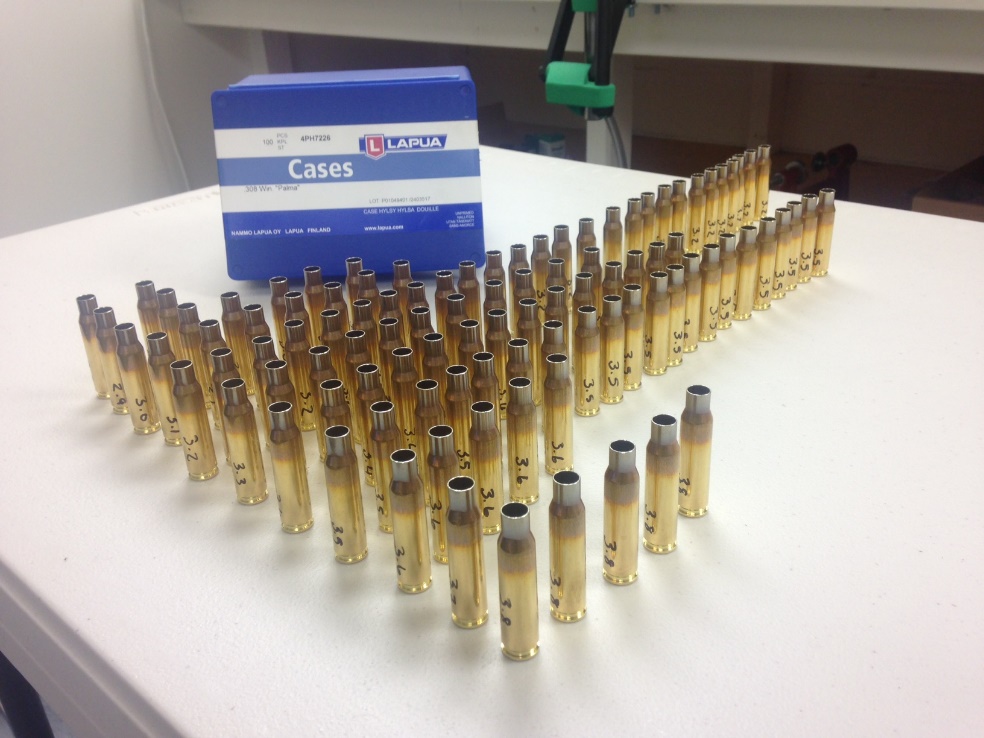
We then selected ten pairs of cases, again from lightest to
heaviest, matching as closely as possible the weights of each pair. These were
then shot
once to fireform the cases,
and kept in sequence as shown here:
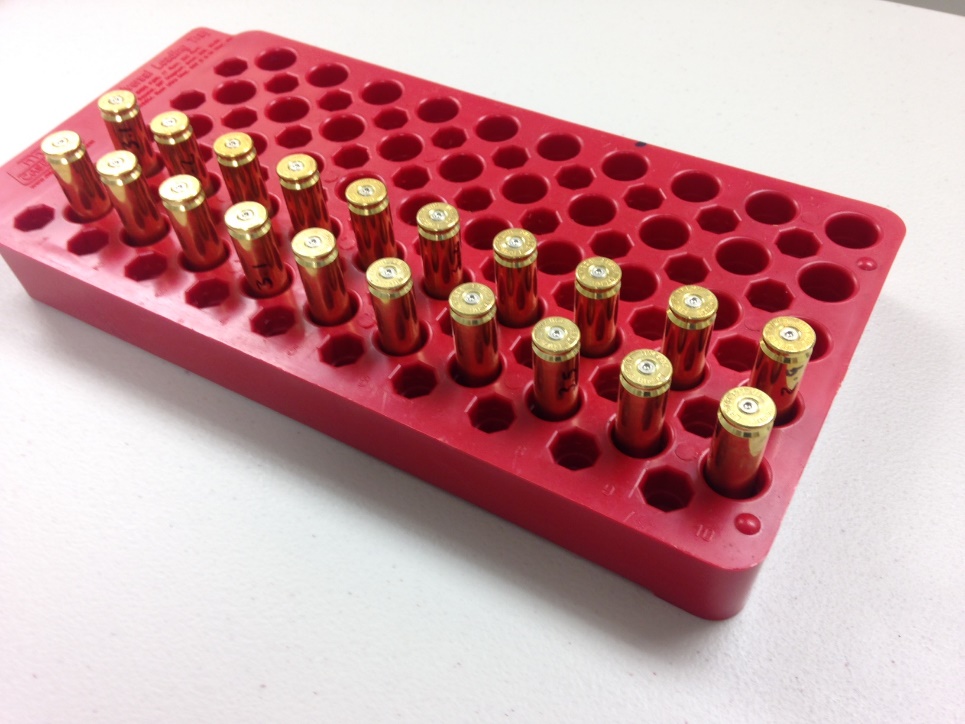
Cases tested were:
Norma: 223R and 308W
Lapua: 223R and 308W Palma
Peterson 308W SPR (small primer)
Brand "A”: 223R
Brand "B”: 308W
Brand "C”: 308W x two lots.
Brands "A”, "B” and "C” are widely used. We have chosen not
to name them.
After fire forming, the first row of 10 cases were run in
AZTEC analyse mode to create linear annealing codes for each case, lightest to
heaviest. This test was to establish if there was a linear sequence of codes correlated
to increasing case weight.
Note: Before analysing fire formed cases, ensure that the case mouths are round. If the mouth has been distorted on extraction from the rifle it can affect the code generated. If necessary, necks can be passed over a mandrel to true them before code analysis.
Once the best average annealing code was chosen,
all 10 of the second row of cases were annealed on that one code setting. This
was to establish if annealed hardness increased in a linear fashion as the case
weight increased.
As a baseline for the following tests, we checked the neck
hardness of Lapua virgin brass in both 223R and 308W Palma. We chose Lapua
because of its reputation amongst competitive shooters, and also because the
virgin brass is not tumbled or polished to remove annealing marks. These
processes as used by most manufacturers can give a "false hard” reading as
discussed in Annealing Under the Microscope Part 1. Lapua is supplied "as
annealed” out of the box. These were the results:
Table 1

Each case was hardness tested at three points around the
neck, and the average of those readings shown in the right-hand column. We note
that the 223R necks were a little harder on average than the 308W. As can be
seen, even with very high-quality brass there are still minor variations in
hardness for cases out of the same box.
A note on virgin brass: If virgin cases are loaded straight out
of the box without any sizing, the neck hardness after bullet seating and fire
forming, at least in our test rifles, is on average only +15 HV above virgin –
not a lot. Surprisingly we have found
that these cases tend to under-anneal on the first reloading
cycle. It is only after cases have been
sized at least once that consistent annealed neck hardness will be achieved
reload to reload. This is due to the level of "stored energy” which sizing
creates.
Therefore, reloaders should either:
directly load virgin
cases and not anneal until the second reloading cycle,
or simply run virgin cases through a neck die with expander
before starting the first load. This will pre-harden the cases sufficiently to
ensure the first and every subsequent anneal gives repeatable results.
In the following tests, virgin cases were pre-sized as above
before loading and fire forming.
Hypothesis
Our hypothesis for
the following tests was that if there is a linear progression of both AZTEC codes
and annealed hardness which correlates to case weights, then at least a
significant portion of the weight variation must be located in the neck and shoulder region of the cases – the
zone targeted for annealing. If there is no linear sequence of codes and
annealed hardness, then any weight variation must be located primarily in the
case head and is therefore not important for annealing.
We started with Brand
"B” 308W.
These cases were chosen first because they had a large
weight spread.
Table 2

This showed a clear correlation between case weight and
AZTEC code. As the case weight increased, more energy was required to
generate a higher code. We then annealed the second row of fireformed cases,
annealing all on code 0160.
These were the results:
Table 2A
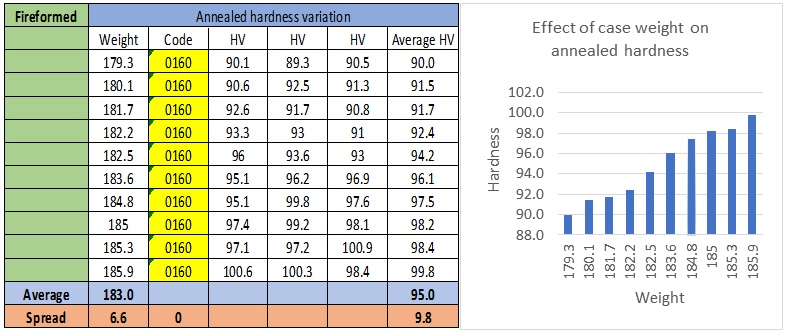
The weight spread for these cases was 6.6 Gr. The hardness
variation was 9.8 HV, ranging from the lightest case 179.3 Gr. to the heaviest
185.9 Gr. Again, this showed a clear correlation between case weight and
annealed hardness. There appears to be no doubt that a significant
portion of the weight variation of these cases is located in the targeted neck
and shoulder annealing zone.
We then tested Brand
"C” 308W. These cases had a smaller, but still significant weight spread.
Table 3

These cases had a weight spread of 3.9 Gr. and an AZTEC code
spread of 4. The codes showed an upward trend with weight, but not perfectly
linear.
Checking for annealed hardness using code 0150 for all cases gave these results:
Table 3A
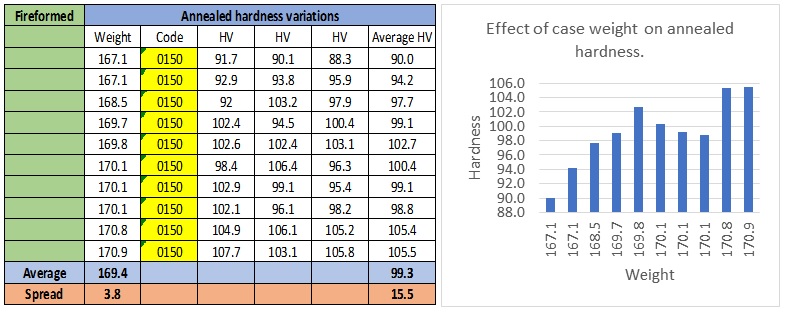
This showed a very large hardness range of 15.5 HV, ranging
from 90 HV to 105.5 HV. The trend was from lightest to heaviest case, but again
not completely linear.
We believe the results for Brands "B” and "C” tend to show
that a significant portion of the case weight variation is located in the neck
and shoulder region in these samples. Sorting by weight would be very important
in order to decide the correct annealing code, but even then, neck hardness
will have a fairly large spread. A further variable is that both Brand "B” and
"C” both have fairly erratic neck wall thicknesses.
Does neck turning
help the annealing accuracy of erratic brass?
We then checked on the effects of neck turning on annealing result. We repeated the process with
Brand "C” 308W (Tables 3 and 3A) from a fresh lot# of virgin brass. The necks
were lightly turned to remove high spots. These were the results:
Table 4
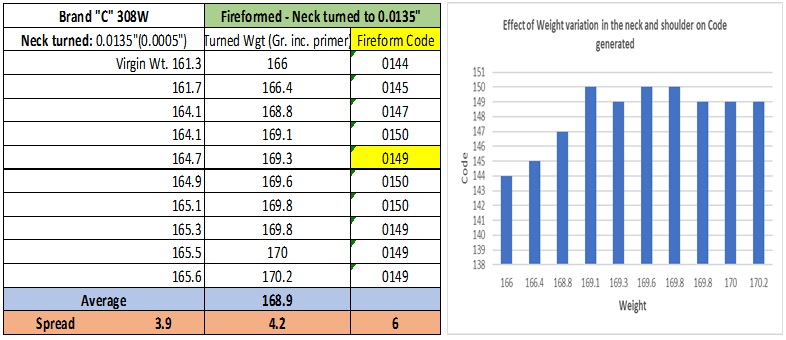
Weight spread after neck
turning was 4.2 Gr. AZTEC code spread was 6. We then annealed the second row of
cases using code 0149.
Table 4A
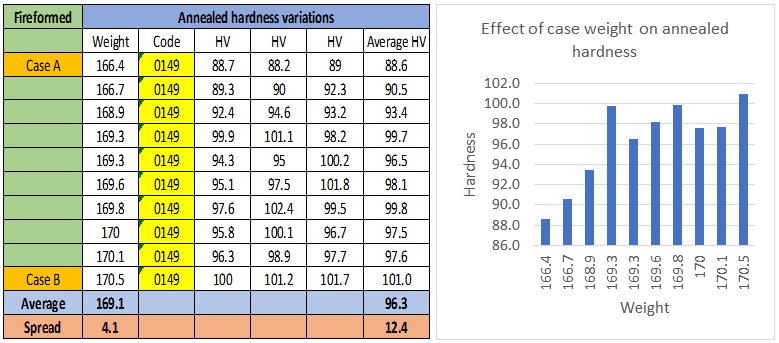
Despite removing most of the neck wall variables by neck
turning, there was still a large
variation of both AZTEC codes and annealed hardnesses. This seems to
indicate that significant weight variation still existed in the shoulder and
front section of the body of these cases.
To check if there were any actual dimensional differences,
we sent the lightest case (Case A in
the above table) and the heaviest case (Case
B) to Andrew Ouwejan at the Metlab Laboratory for longitudinal sectioning.
Note that both cases had been lightly neck turned to remove high spots. After
turning, both still showed neck wall variations from 0.013” to 0.014”. Note
also that because the sectioning process is minutely offset from the diameter,
the dimensions below in microns are fractionally larger than when measured in
0.001”s with a ball micrometer. This effect is consistent on both sides of each
case.
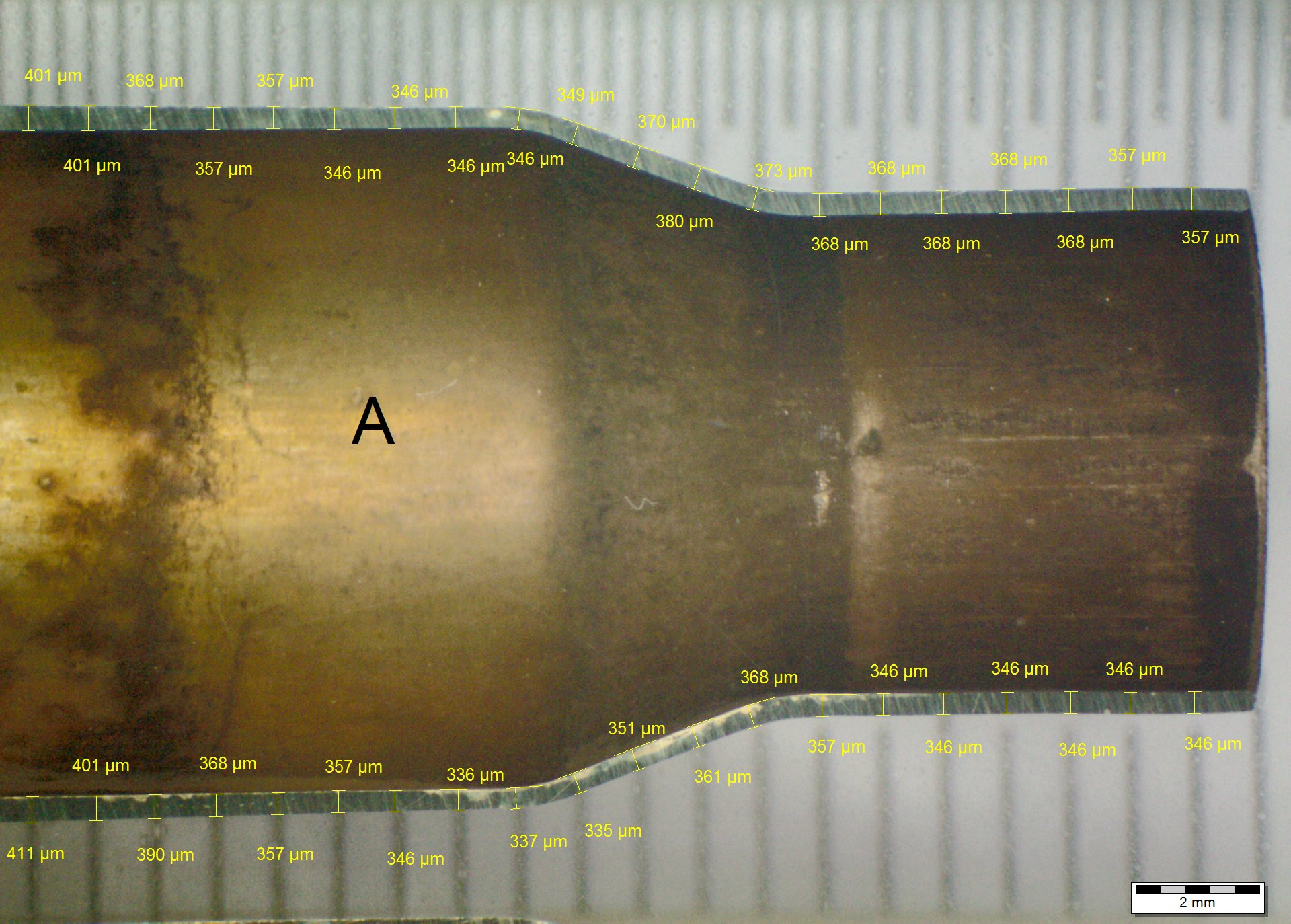
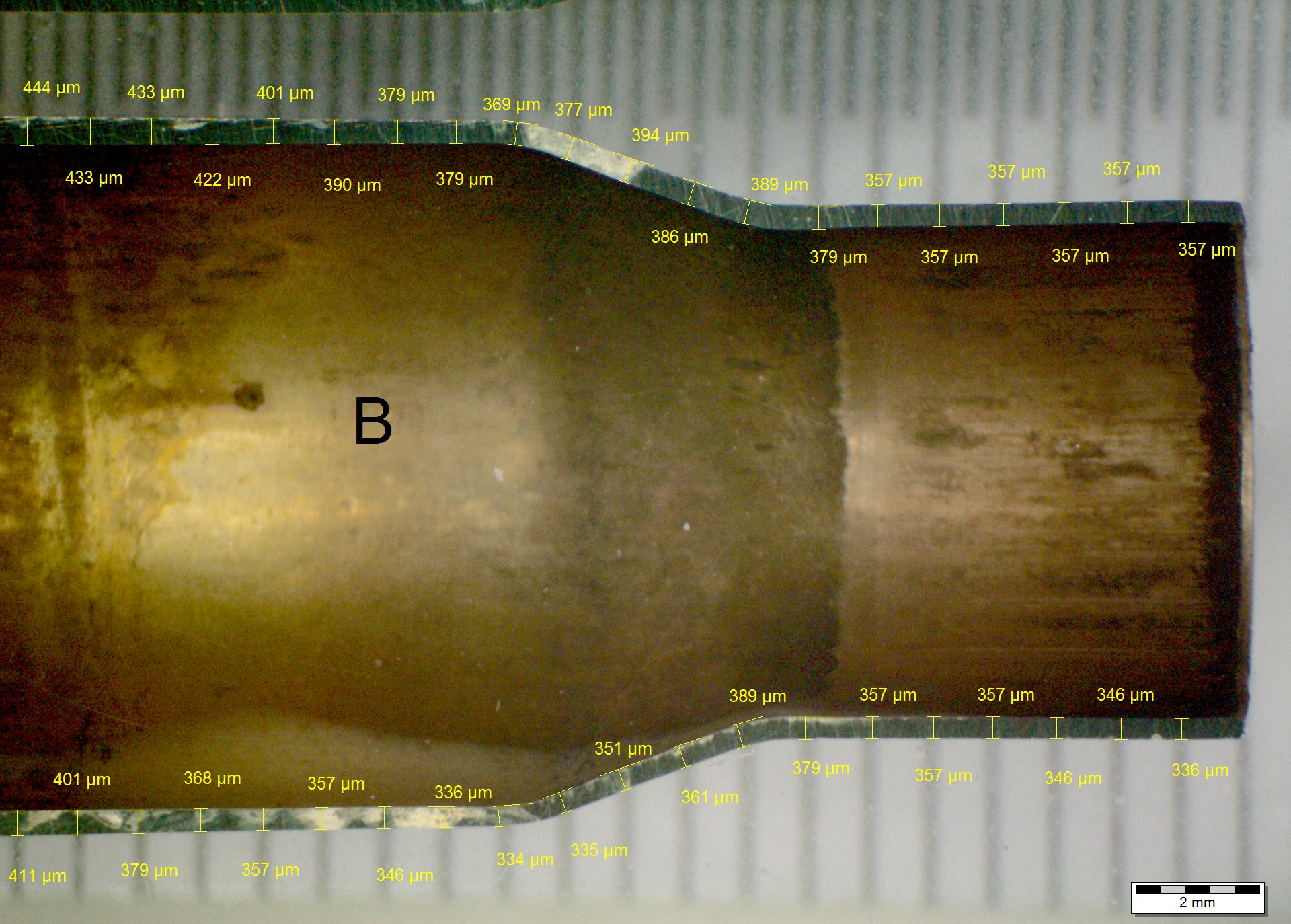
The lower sides of both cases in the photos are reasonably
consistent. The upper side of Case B, however, is considerably thicker by some
9.6% from the neck/shoulder junction right back through the body for at least
8mm from the point of the shoulder. This confirms that not only is Case B
heavier than Case A in the targeted annealing zone, but also that the weight
variation is off center.
Next, we tested Lapua
308W Palma cases, the first of the "premium” brands. These were the
results:
Table 5
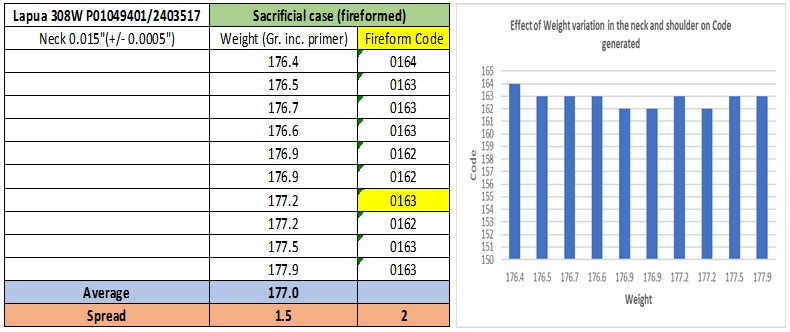
The case weight variation was only 1.5 Gr. across the entire
box. The AZTEC codes only ranged from 161 to 163, but with no correlation to the
weights i.e. there was no pattern of lighter cases generating lower code
numbers. When code 0163 was
selected for the second ten cases these were the results:
Table 5A
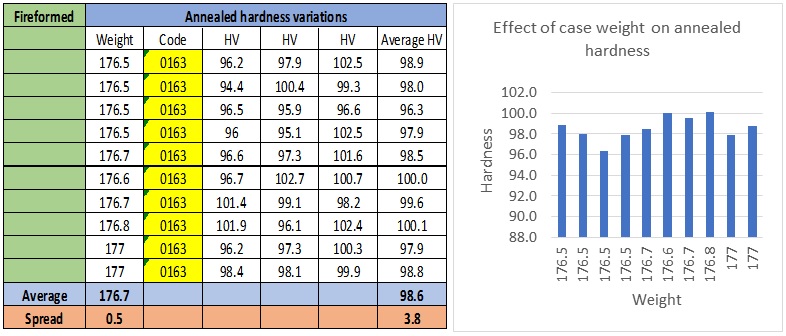
The annealed hardness variation was just 3.8 HV, or in line
with virgin Lapua brass. Again, there was no correlation between case weights and
hardness. It is probable that the minor weight variations seen were
located in the head of the cases, not the
neck and shoulder.
The next 308W tests were Norma, the second "premium” brand.
Table 6
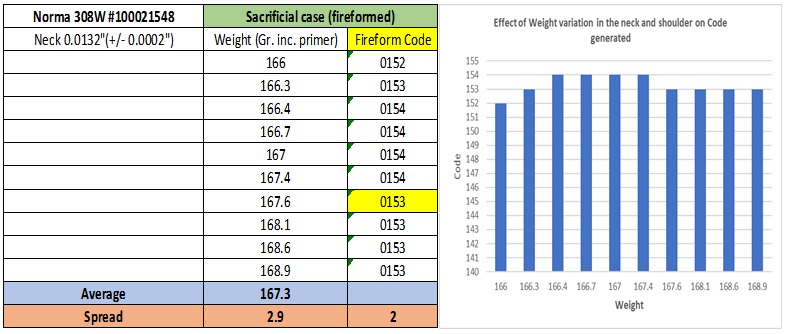
Again, case weight variation was minimal at 2.9 Gr. AZTEC
codes ranged from 151 to just 153, with no correlation between weight and
codes.
When all the second ten cases were annealed on code 0153, these were the
results:
Table 6A
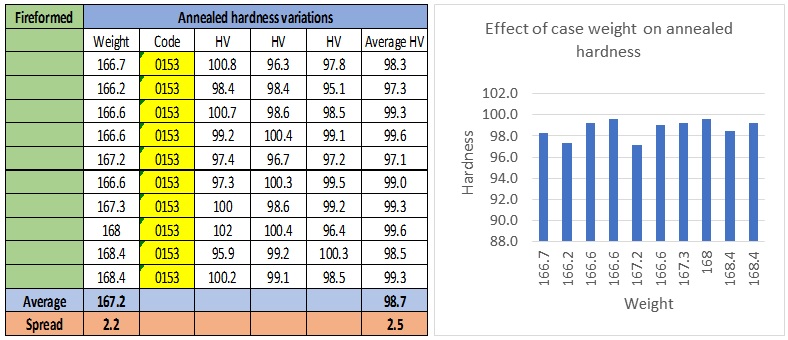
Annealed hardness variation was excellent at only 2.5 HV,
and as with Lapua, showed no correlation to case weight.
Comparing these results to "B and "C” tests, firstly, the case weight
variations are much lower in Norma and Lapua. Secondly, what variation there is does not
appear to be in the neck and shoulder region. It is therefore more likely to be
in the head of the cases.
Next, we tested Peterson
SPR 308W the third "premium” brand.
Table 7
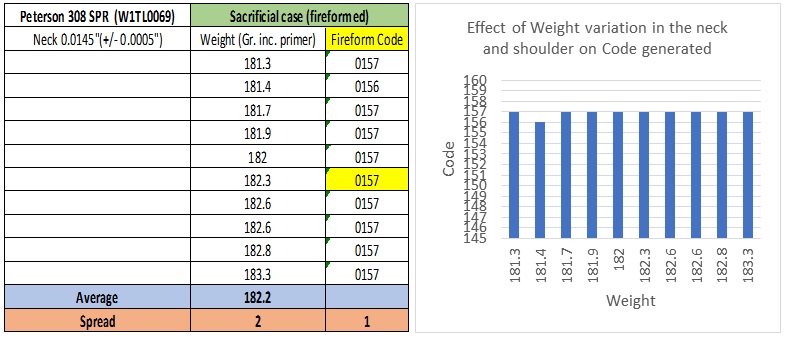
Weight spread was only 2 Gr.
and AZTEC code spread was only one. In fact, nine out of ten codes were 157.
The second group of cases were all annealed on Code 0157 with these results:
Table 7A
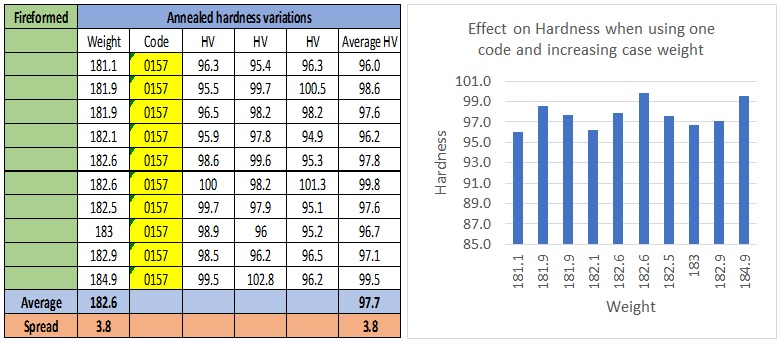
The Peterson cases showed no
correlation between weight variability and either AZTEC code generation or
annealed hardness, and therefore, as with Norma and Lapua, we conclude
that there is no significant weight variation in the targetted neck and
shoulder region. They showed excellent consistency.
As a final 308W test, we then shot and annealed these same ten Peterson cases for another cycle to test repeatability. These were the results:
Table 8
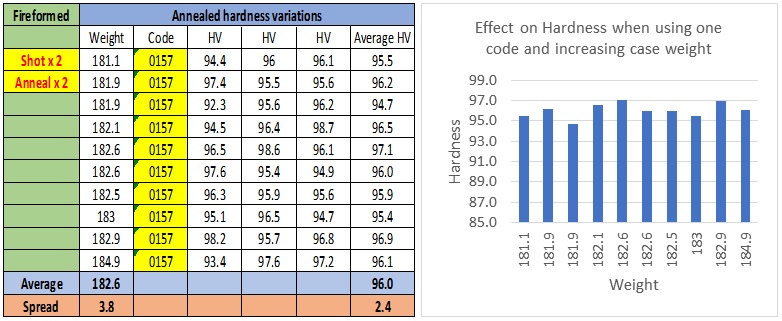
If anything, the annealed
hardness case to case was even more consistent than the once fired tests.
Average neck hardness was within 1.7 HV of the previous once fired cycle.
…………………………………………………………………………….
223 R tests.
The above 308W series of tests were then repeated with 223R cases. These were the results:
Brand "A”:
Table 9
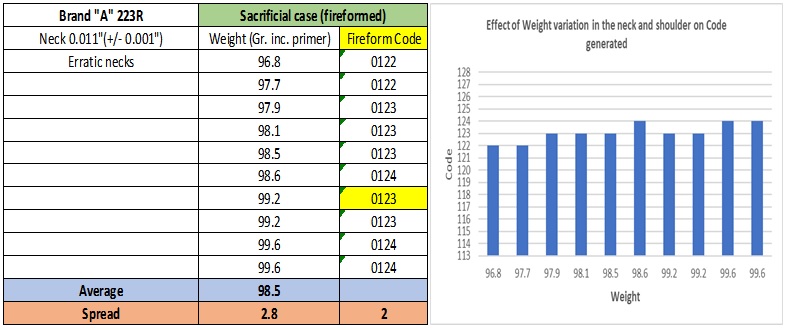
Weight spread was 2.8 Gr. with a spread of AZTEC codes of
just 2. The second row of cases were all annealed using code 0123.
Table 9A
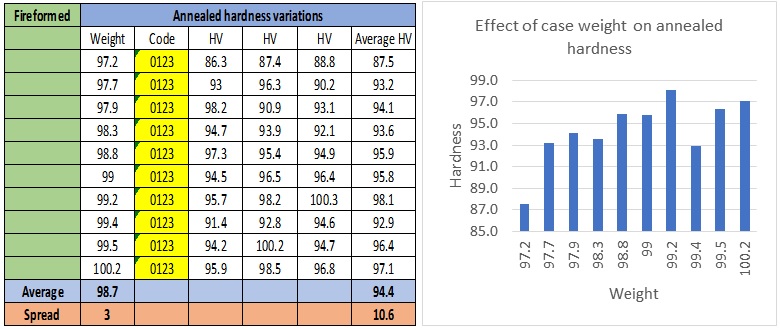
These cases generated reasonably consistent AZTEC codes. Despite
having a relatively small weight variation, the second set of cases showed a significant
annealed hardness variation, trending from lightest to heaviest. However,
most of that variation is attributed to one "flier” which was the
lightest case in the batch. Apart from that, the results were reasonable, ranging
from 93.2 HV to 98.1 HV.
Now Lapua 223R:
Table 10

Weight spread was just 1 Gr. and AZTEC code spread was 2.
All the second row of cases were annealed using code 0138.
Table 10A
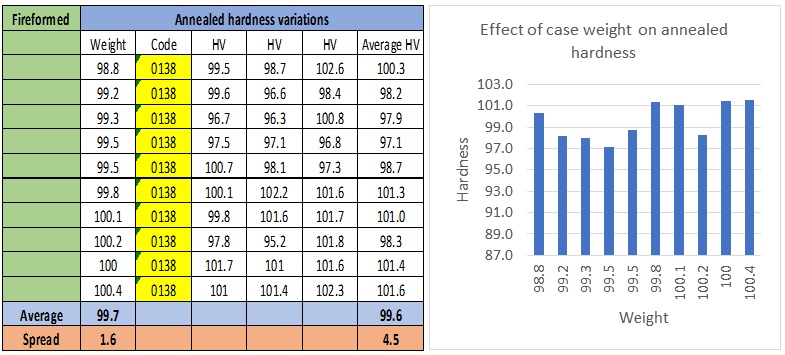
This shows excellent consistency, both with AZTEC
codes and with annealed results, which were comparable in spread to virgin
brass.
Then Norma 223R:
Table 11
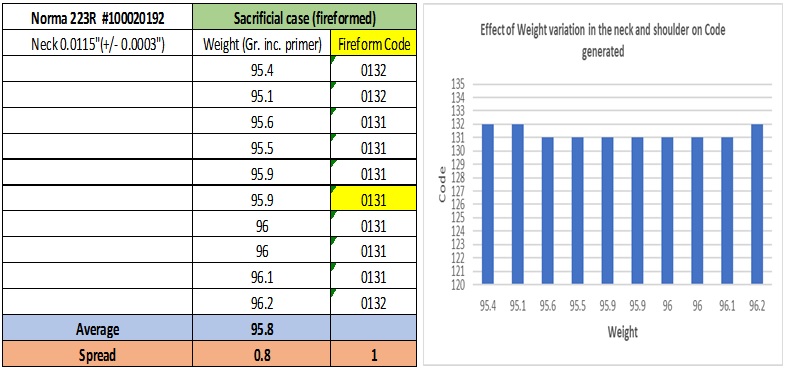
Weight spread was just 0.8 Gr. with an AZTEC code spread of
1. The second row of cases were all annealed using code 0131.
Table 11A
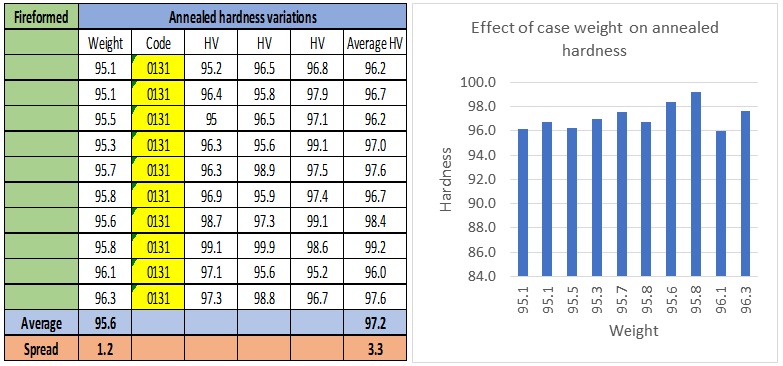
As with Lapua, these results
show excellent consistency, both in AZTEC codes generated and annealed
hardness. There is no correlation between the minor weight variations and either
the AZTEC codes or annealed hardness. We believe this indicates that
these cases had minimal weight variation in the targetted annealing zone.
Conclusions:
Returning to the original
five questions, we now have some answers.
1.
What is
responsible for AZTEC analysis generating different annealing codes for the
same brass? The above evidence
demonstrates that if the mass of brass within
the targeted annealing zone varies even fractionally case to case, then a
different AZTEC code may be generated. If cases are exactly the same,
then the same code will be generated. The Table
4 test of neck turned Brand C 308W cases illustrates that even when
neck walls are trued, and case weight is similar, big variations can still
occur in both AZTEC codes and annealed hardness if the rest of the target zone,
i.e. the shoulder and front section of the body is still inconsistent.
2.
Where in
the case does the weight variation occur? On this evidence, overall case weight variation was minimal in all
packs of Lapua, Peterson and Norma cases. What variation there was did not
affect either the AZTEC code generation or annealed hardness. Therefore, any
weight variations with those cases must be in the case heads. Brands "A”, "B”
and "C” showed clear evidence that at least a portion of the case weight
variation was in the targeted annealing zone. This may have implications beyond
the scope of this study, in particular variable case volume.
3.
Does
variable case weight result in variable annealing hardness? - That depends on the cases. With all three
brands "A”, "B” and "C”, we saw a considerable increase in annealed hardness as
case weight increased. The Lapua, Peterson and Norma cases showed no such
trend.
4.
If so,
what is an acceptable tolerance? –
That depends on the reloader's expectations. The lowest single hardness reading
in all the above tables is 85.2 HV. That is not low enough to ruin that case,
and when shot and resized, it would regain hardness. The highest single reading
is 106.4 HV, which is still definitely annealed. For the reloader who just
wants to extend the life of their cases, that sort of tolerance may be
acceptable. Neck tension, however, would not be very consistent. For the
competitive shooter, in particular at long range, the tighter the HV tolerance
the more consistent the neck tension (and hence velocity SD/ES) will tend to
be.
5.
Are some
brands better than others? The above
tests show results for two boxes of Lapua (223R and 308W), two of Norma, one of
Peterson, one of "Brand A” one of "Brand B” and two of "Brand C”. We cannot say
for sure that every box of Lapua, Peterson or Norma will be as good as those
tested here, nor that brands "A”, "B” and "C” will always be that erratic. On
the above evidence however, batching cases by weight would show greatest
benefit with brands "A”, "B” and "C”. It would appear to be less important for
Lapua, Peterson or Norma, all of which showed excellent consistency.
Note that all cases tested in this study were fireformed
once from virgin brass. We strongly recommend that sacrificial cases are
analysed at the fireformed, unsized stage. That is when annealing should
normally be done. Depending on the rifle chamber specification, unsized cases
will usually generate an AZTEC linear code lower than sized cases. We used
stock standard Remington 700 rifles for both the 223R and 308W tests.
Fireformed AZTEC linear codes were consistently 2 lower than sized or virgin
cases.
Note: the
other major factor in accurate annealing is neck wall consistency. Neck wall
thicknesses should be checked before even starting to weigh cases. Each 0.001”
will make a significant difference, as can be seen in our Standard program
listings.
Recap on selecting sacrificial cases.
Not many reloaders would want to sacrifice ten cases, as we
did in each of these tests, in order to establish the correct AZTEC linear code.
That is why we have highlighted the importance of weight sorting cases. While
this study shows that weight sorting is less important with Lapua, Peterson or
Norma brass, we cannot rule out that some lots of those brands might be less uniform
than those we tested. For the sake of a little extra effort we think it is best
practice to weigh all new batches of brass.
Once the most representative median weight is established,
one or more sacrificial cases can be analysed. As noted above, ensure that case mouths are round before sacrifice. If several median cases are
sacrificed, they should be within +/- 1 code of each other. The increments
between codes are very fine, and that range will give correct annealing.
Having gone to this effort, make sure to keep your case lots separate.
If lot numbers get mixed it can be almost impossible to re-sort them.
Acknowledgement
We would like to thank Donald Eigler for his advice and
editing assistance.
